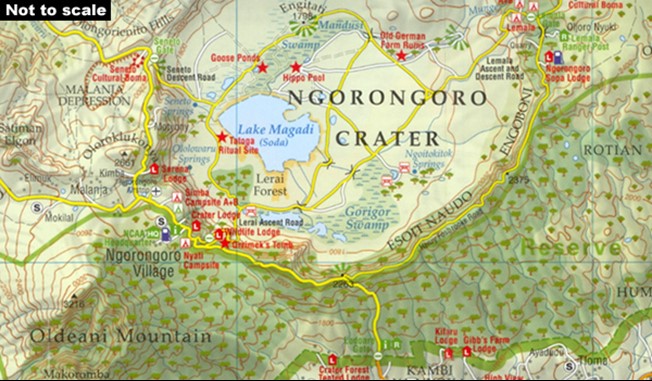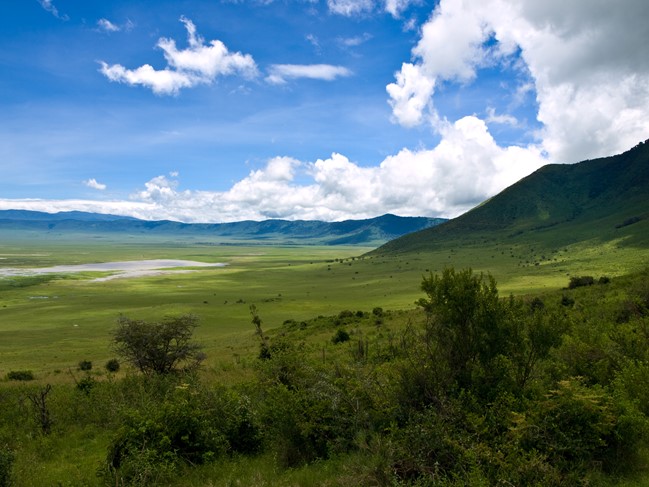Below are some of the favourite parks in the northeast region of Tanzania for safaris before or after a climb of Mount Kilimanjaro. We organise 4D/3N packages to Ngorongoro, Tarangire and Manyara, as well as longer tours into the Serengeti.
Serengeti National Park
Location: Northern Tanzania, 208 miles from Arusha, stretching north to Kenya and bordering Lake Victoria to the west.
History: Tanzania's oldest and most popular national park, also a world heritage site and recently proclaimed a 7th worldwide wonder, the Serengeti is famed for its annual migration, when some six million hooves pound the open plains, as more than 200,000 zebras and 300,000 Thomson's gazelle join the wildebeest’s trek for fresh grazing. Yet even when the migration is quiet, the Serengeti offers arguably the most scintillating game-viewing in Africa: great herds of buffalo, smaller groups of elephant and giraffe, and thousands upon thousands of eland, topi, kongoni, impala and Grant’s gazelle.
Size: 14’763 sq km.
Geography / Habitats: The Serengeti is the best known and greatest wildlife sanctuary in the world. The name comes from the Maasai 'siringet' which means 'endless plains', and the Serengeti is just that. The Serengeti's terrain is varied: the vast treeless central Serengeti Plains, savannah dotted with acacia trees, magnificent rock outcrops called kopjes, reverie bush, thick scrub to streams, rivers, small swamps and lakes. These features give the Serengeti Park a fascinating variety of habitats. Survey estimates indicate more than 3000 lions, 1,600,000 wilder beasts and 500,000 zebras. There are more than 400 bird species.
Animals: Wildebeast (circa 1 million), Lions, Elephant, Rhino, Gazelle, Cheetah, Buffalo, Warthog, Flamingo, Waterfowl, Waterbucks, Giraffe, Hippo, Impala, Zebra, Dik-dik, Leopard, Hyena and over 400 bird species have been recorded from Ostrich to the secretary bird. The list goes on and on….
Of interest: Hot air balloon safaris, walking safari, picnics, game drives, bush lunch/dinner can be arranged with hotels/tour operators. Maasai rock paintings and musical rocks.
Accommodation Options: Lodges, fixed tented camp and camping.
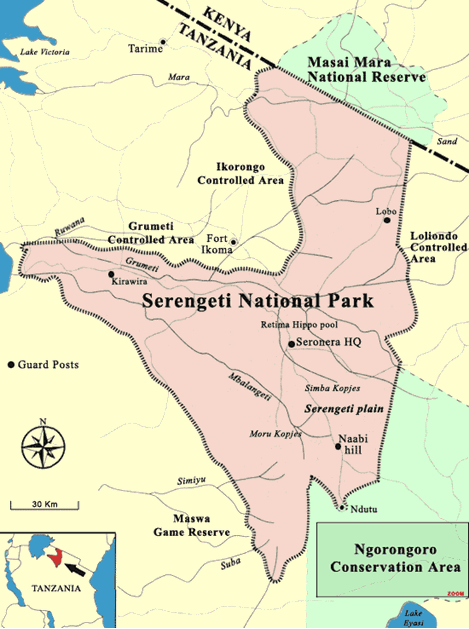
Arusha National Park
Location: Northern Tanzania, northeast of Arusha town.
History: Established in 1960 and known as Ngurdoto Crater National Park until 1967. Arusha’s name comes from the local people known as the Waarusha. Managed by the Tanzanian National Parks.
Size: 137 sq km
Geography / Habitats: Arusha National Park is often overlooked by tourists due to the closeness of the Serengeti, Ngorongoro, Lake Manyara and Tarangire however due to this the crowds are low and the park offers a perfect introduction or a chilled last day to a longer safari. The other attraction of the park is being able to stretch your legs as you embark on a walking safari. The Park is very diverse and dominated by Tanzania’s 2nd highest peak Mt Meru. It has a lot of montane forests, the Ngurdoto Crater (a mini Ngorongoro Crater), cliffs, marshland, rolling grassy hills and the seven Momela Lakes.
Animals: Blue Monkeys, Colobus Monkeys, Buffalo, Warthog, Flamingo, Waterfowl, Waterbucks, Giraffe, Zebra, Dik-dik, Elephant (rare), Leopard, Hyena.
Of interest: Walking Safaris, fantastic views of Kilimanjaro and Mt Meru, low crowd levels and beautiful scenery.
Accommodation Options: Lodges, local hotel or Camping.
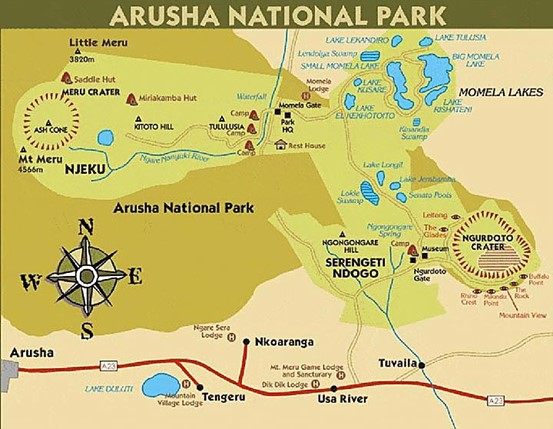
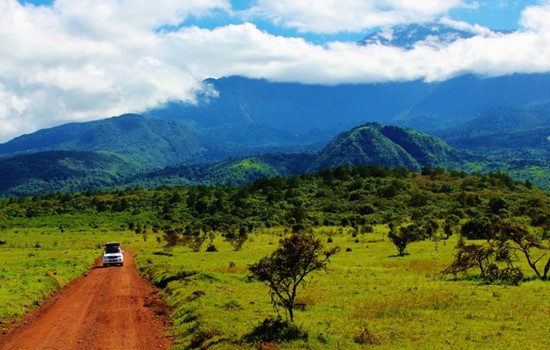
Lake Manyara National Park
Location: Northern Tanzania, 1 ½ hours west of Arusha town.
History: The area around Lake Manyara was once famous has a hunters heaven but thankfully the park is now established, protected and managed by the Tanzanian Park Authorities.
Size: 330 sq km of which 200 sq km is Lake when water levels are high.
Geography / Habitats: Stretching for 50km along the base of the rusty-gold 600-metre high Rift Valley escarpment, Lake Manyara is a scenic gem, with a setting extolled by Ernest Hemingway as “the loveliest I had seen in Africa”. The compact game-viewing circuit through Manyara offers a virtual microcosm of the Tanzanian safari experience. The entrance to the park is a lush forest with many ancient mahogany trees and many monkeys. This then opens up to a large grassy floodplain and the lake itself with a stunning backdrop of jagged blue volcanic peaks that rise from the endless Maasai Steppes. Inland of the floodplain, a narrow belt of acacia woodland is the favoured haunt of Manyara’s legendary tree-climbing lions and impressively tusked elephants.
Animals: Wildebeast, the legendary tree climbing Lions, Elephant, Buffalo, Warthog, Flamingo, Waterfowl, Waterbucks, Giraffe, Hippo, Impala, Zebra, Dik-dik, Leopard, Hyena and over 400 bird species have been recorded.
Of interest: Game drives, night game drives, canoeing when the water levels is sufficiently high. Cultural tours, picnics, bush lunch/dinner, mountain bike tours, abseiling and forest walks on the escarpment outside the park.
Accommodation Options: Lodges, local hotels, fixed tented camp and camping.
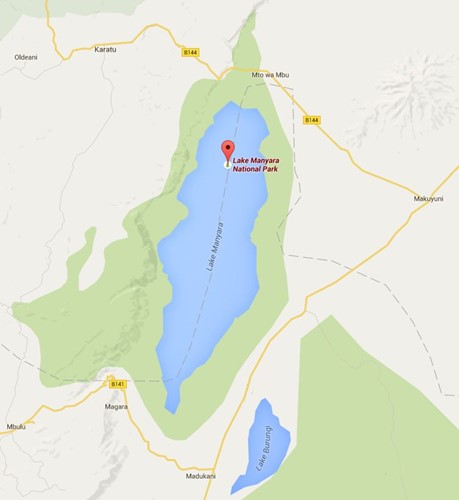
Tarangire National Park
Location: Northern Tanzania, 75 miles from Arusha.
History: The National park takes its name from the Tarangire River, which crosses it lengthwise, giving support to a large wildlife population even during the dry season. During this season, between June and October, thousands of animals including wildebeests, zebras, elands, elephants, buffaloes, hartebeests and more migrate from the dry Maasai steppe to the Tarangire River.
Size: 2850 sq km.
Geography / Habitats: It is the sheer vast number of baobabs that first capture the eye as you enter Tarangire National Park. The gently rolling countryside is dotted with these majestic trees, which seem to dwarf the animals that feed beneath them. Lake Burungi area is in the north-western part of the park and a drive in this area will offer you fascinating opportunities to watch large herds of flamingos and other species of birds feeding on aquatic organisms in Lake Burungi. This area also contains an isolated population of Oryx. The landscape and vegetation are incredibly diverse with a mix that is not found anywhere else in the northern safari circuit.
Animals: Wildebeest, Lions, Elephant, Rhino, Gazelle, Cheetah, Buffalo, Warthog, hartebeest, long-necked gerenuk, Impala, Zebra, Dik-dik, Leopard, Hyena and fringe-eared oryx. The swamps are the focus for 550 bird varieties, the most breeding species in one habitat anywhere in the world. Tarangire's pythons climb trees, as do its lions and leopards, lounging in the branches where the fruit of the sausage tree disguises the twitch of a tail.
Of interest: Guided walking safaris. Day trips to Maasai and Barabaig villages, as well as to the hundreds of ancient rock paintings in the vicinity of Kolo on the Dodoma Road
Accommodation Options: Lodges, fixed tented camp, camping and local options outside of the Park.
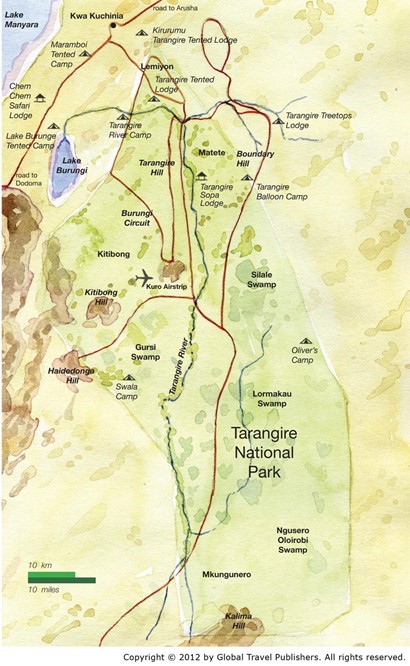
Ngorongoro Crater and Conservation Area
Location: Northern Tanzania, 110 miles west of Arusha.
History: The Ngorongoro Conservation Area is a conservation area and a UNESCO World Heritage Site situated in the Crater Highlands area of Tanzania. The Ngorongoro area originally was part of the Serengeti National Park when it was created by the British in 1951. Maasai continued to live in the newly created park until 1959 when repeated conflicts with park authorities over land use led the British to evict them to the newly declared Ngorongoro Conservation Area. The Ngorongoro Conservation Area Authority is the governing body regulating use and access to the NCA. Based on fossil evidence found at the Olduvai Gorge, it is known that various hominid species have occupied the area for three million years.
Size: 8288 sq km.
Geography / Habitats: Land in the conservation area is multi-use; it is unique in Tanzania as the only conservation area providing protection status for wildlife whilst also allowing human habitation. Land use is controlled to prevent negative effects on the wildlife population. For example, cultivation is prohibited at all but subsistence levels. The Conservation Area is part of the Serengeti ecosystem, and to the northwest, it joins the Serengeti National Park and is contiguous with the southern Serengeti plains. The south and west of the area are volcanic highlands, including the famous Ngorongoro Crater and the lesser known Empakai. The southern and eastern boundaries are approximately defined by the rim of the Great Rift Valley wall, which also prevents animal migration in these directions.
Animals: A population of approximately 25,000 large animals with reputedly the highest density of mammalian predators in Africa lives in the region including the Black Rhinoceros, Hippopotamus, Wildebeest, Zebra, Eland, Grant's and Thompson's Gazelles, Lions, Leopards, Elephants, Wildebeest, Hartebeest, Spotted Hyenas, Jackals, Cheetahs, African Wild Dog and Buffalo. In summer, enormous numbers of Serengeti migrants pass through the plains of the reserve, including 1.7 million Wildebeest, 260,000 Zebra, and 470,000 Gazelles. Waterbuck occurs mainly near Lerai Forest and Servals can be found on the plains to the west.
Of interest: No trip to the Conservation is complete without venturing into the Ngorongoro Crater!
Accommodation Options: Lodges, fixed tented camp, camping and local options outside of the Park.
